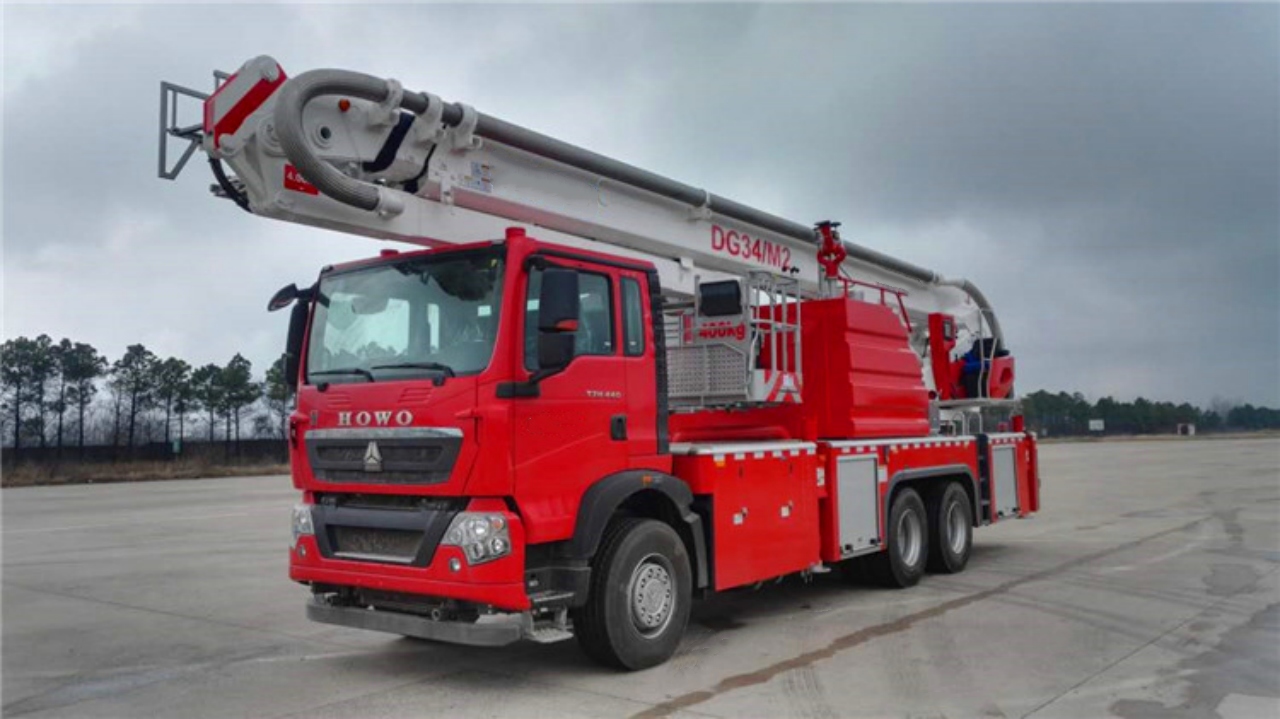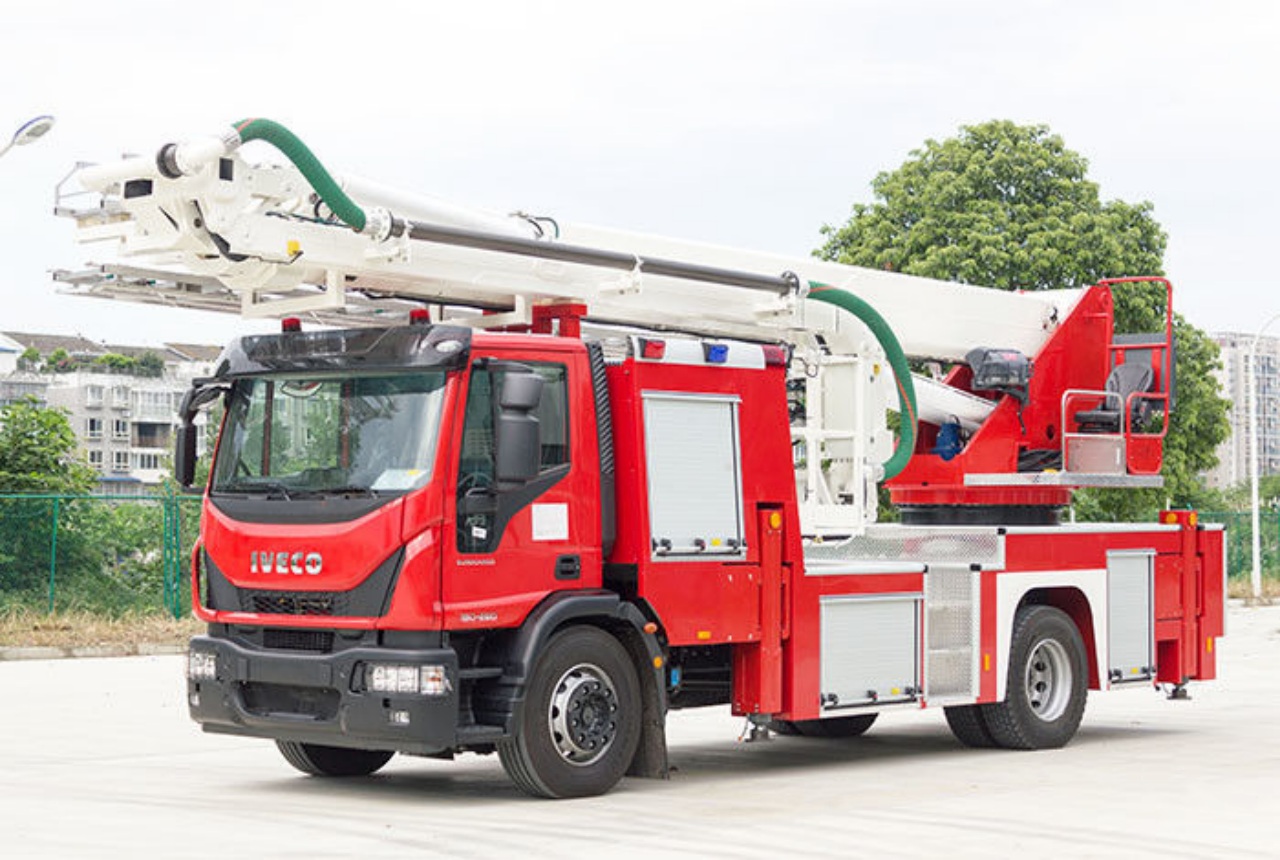In the dynamic and often dangerous world of firefighting and rescue, specialized equipment is paramount. Among the most imposing and versatile vehicles in a fire department‘s fleet is the platform fire truck. Often mistaken for or grouped loosely with ladder trucks, the platform truck, also known as an aerial platform, tower ladder, or basket truck, possesses unique characteristics and fulfills critical functions that distinguish it and make it indispensable on the modern fireground. Its core purpose revolves around providing a safe, stable, elevated working area, enabling firefighters to perform a variety of crucial tasks more effectively and safely than with ground ladders or even traditional aerial ladders alone.
Defining the Platform Truck: More Than Just a Ladder
At first glance, a platform truck resembles a standard aerial ladder truck. Both feature a large, hydraulically operated ladder or boom mounted on a truck chassis, designed to reach significant heights. The key difference lies at the tip of this aerial device. While a traditional ladder truck (often called a straight stick or tiller ladder) has an open ladder extending to its full length, potentially with a nozzle at the tip, a platform truck terminates in an enclosed or semi-enclosed basket or platform. This platform is the heart of the vehicle’s specialized functionality. It typically provides space for 2 or more firefighters, features integrated controls for the aerial device, often houses a high-volume water cannon (master stream device), and includes safety anchor points, tool storage, and sometimes even breathing air connections.
This seemingly simple addition of a platform transforms the operational capabilities of the aerial apparatus. It shifts the primary function from simply providing a climbing route or a high anchor point for a nozzle to offering a secure, multi-purpose elevated workstation.

Core Function 1: Elevated Master Stream Operations
One of the most critical functions of a platform fire truck is delivering large volumes of water from an elevated position. Fires in multi-story buildings, large commercial structures, or industrial facilities often require water streams that can penetrate deep into the structure or cool large surface areas from above or at the level of upper floors.
The platform provides an exceptionally stable base for a high-capacity water monitor (deck gun or water cannon). Firefighters operating from within the basket can precisely direct these powerful streams, often flowing 1,000 gallons per minute (GPM) or more (around 3,800 liters per minute), directly onto the seat of the fire or onto exposures (nearby buildings threatened by the fire). This elevated attack can be far more effective than ground-based streams, which may be blocked by lower floors or unable to reach the necessary height and angle. The platform allows for better targeting, minimizing water damage to unaffected areas while maximizing the impact on the fire itself. Furthermore, operating the stream from the relative safety of the basket is significantly less hazardous than trying to manage a high-pressure nozzle at the tip of an open ladder.
Core Function 2: Rescue Operations
Perhaps the most dramatic and life-saving function of a platform truck is facilitating rescues from heights. In situations where people are trapped on upper floors, balconies, or rooftops due to fire or other emergencies (like structural collapse or hazardous material incidents), the platform offers a safe and relatively spacious refuge.
Unlike a traditional ladder, where victims might need to climb down, potentially while injured, panicked, or facing mobility challenges, the platform can be positioned directly alongside a window or balcony. Firefighters can assist multiple victims, including children, the elderly, or unconscious individuals, directly into the safety of the basket. The platform provides a secure environment during the potentially harrowing descent, significantly reducing the risk for both the rescuers and the rescued compared to carrying or guiding someone down a steep ladder. It’s particularly valuable for non-ambulatory victims who cannot self-evacuate via a ladder.

Core Function 3: Ventilation and Access
Effective ventilation is crucial in firefighting. Removing smoke, heat, and toxic gases from a burning building improves visibility for firefighters searching inside, reduces the risk of flashover or backdraft, and can help confine the fire. Platform trucks provide unparalleled access to roofs and upper-story windows for ventilation operations.
Firefighters can be safely delivered directly to the roofline or alongside windows, bringing tools like axes, saws, and hooks with them in the basket. From this stable position, they can perform vertical ventilation (cutting holes in the roof) or horizontal ventilation (breaking windows) far more safely and efficiently than by climbing ground ladders or aerial ladders and working precariously at height. The platform allows them to work with both hands, operate power tools safely, and maintain a secure footing, significantly reducing the risk of falls.
Beyond ventilation, the platform provides general access for other tasks. Firefighters might use it to investigate conditions on upper floors, check for fire extension, or perform an overhaul (searching for hidden fires after the main body of fire is extinguished) in hard-to-reach areas.
Core Function 4: Observation and Command Support
The elevated perspective offered by a platform truck provides an invaluable vantage point for the incident commander (IC). By positioning the platform above the scene, the IC or a designated spotter can gain a comprehensive overview of the incident layout, fire progression, building conditions, potential hazards, and the deployment of resources. This “eye in the sky” perspective aids significantly in situational awareness and strategic decision-making, allowing for more effective command and control of the entire operation.

Enabling Features and Advantages
The functions described above are made possible by the specific design features of the platform truck:
- The Platform (Basket): Provides a secure working area, integrated controls, water monitor mounting, tool storage, and safety harnesses/anchor points.
- The Aerial Device: Typically a heavy-duty ladder or articulating boom (or a combination) designed to support the weight of the platform, firefighters, equipment, and the forces exerted by the water stream.
- Stabilizers (Outriggers): Essential for safety, these hydraulic jacks extend outwards and downwards from the truck chassis to create a wide, stable base, preventing the truck from tipping over during aerial operations. Proper deployment is critical.
- Load Capacity: Designed to safely carry multiple firefighters and their equipment, plus withstand the reaction force of the master stream.
Compared to straight ladder trucks, the platform offers enhanced safety and stability for personnel working at height, allows for easier rescue of non-ambulatory victims, provides a better base for operating powerful master streams, and facilitates complex tasks like ventilation with greater security.
Limitations and Considerations
Despite their versatility, platform trucks are not without limitations. They are large, heavy vehicles requiring significant space for setup, particularly for deploying the outriggers. This can be challenging in narrow streets or congested areas. Setup time can also be longer than simply raising ground ladders. Furthermore, they represent a significant financial investment for fire departments in terms of acquisition and ongoing maintenance. Their reach, while substantial, is still finite both vertically and horizontally.

Conclusion: An Indispensable Asset
In summary, the function of a platform fire truck extends far beyond simply reaching heights. It serves as a multi-purpose elevated command center, rescue vehicle, water delivery system, and access tool. By providing a stable and secure working platform at the end of its aerial device, it enables firefighters to perform critical tasks – fighting fires with powerful elevated streams, rescuing trapped individuals safely, ventilating structures effectively, and observing the overall incident scene – with greater safety and efficiency than often possible with other types of apparatus. While large and requiring skilled operation, the unique capabilities offered by the platform truck make it an indispensable asset in the arsenal of any well-equipped fire department facing the challenges of modern structural firefighting and complex rescue scenarios.








